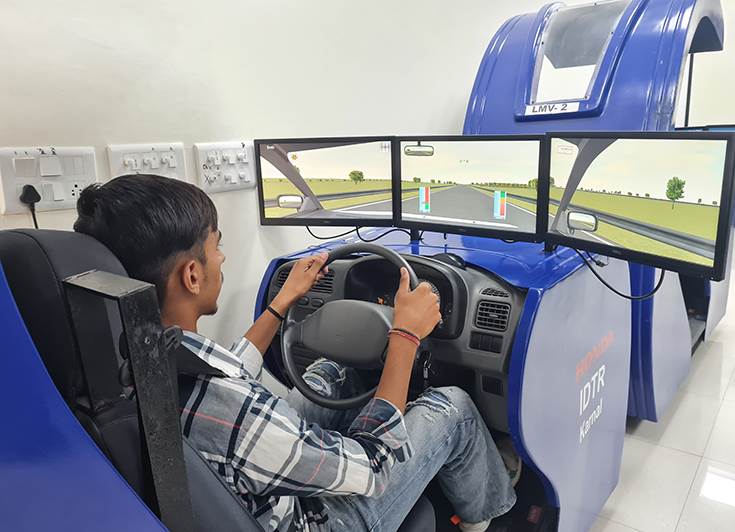Honda Motorcycle & Scooter India (HMSI), through the Japanese automaker’s CSR arm – Honda India Foundation – has trained over 7,000 people at its state-of-the-art driver- and rider-training facility in Karnal, Haryana.
The Karnal Institute of Driving and Traffic Research (IDTR), which is a collaborative initiative between HMSI and the Haryana government, was set up by the Japanese two-wheeler OEM, which is headquartered in Manesar, Haryana. The company has invested Rs 34 crore in the establishment of this state-of-the-art facility which was commissioned in August 2022.
The facility, which is spread over 9.25 acres, has training and testing facilities for two-, three,- and four-wheelers (LMV), as well as heavy motor vehicles (HMV), has thus far trained over 7,000 people who have applied to get the comprehensive driver training by virtue of the advanced simulators, rigorous theory sessions, as well as practical, hands-on training at the test tracks.
The centre also features an Advanced Driver Test Track (ADTT). Honda says it is the first IDTR in India set up by a two-wheeler OEM to have an integrated ADTT to test the riding and driving skills of two-, three-, and four-wheeler drivers, as well as heavy commercial vehicle driving license seekers. The ADTT at IDTR Karnal which was commissioned in June 2023, has so far conducted over 6,000 tests, and has been contributing in eliminating human intervention in the driving assessment and evaluation test.
According to Vinay Dhingra, Senior Director, HR, Admin, IT, and Corporate Affairs, HMSI, “Honda has a global vision to eliminate road accident fatalities by 2050, and when our vision aligned with that of the Government of Haryana, it led to the establishment of this centre, which is the first of such IDTRs where the corporate has invested for the first time.”
The facility is equipped with driving simulators for two- and four-wheelers, as well as heavy commercial vehicles; there are also five smart classrooms with a total capacity to train 200 students at a time by offering both practical and theoretical knowledge. A driving lab comprises cut sections of commercial vehicle engines and other vehicle systems, while the full- and open-cabin truck simulators aid in imparting practical knowledge on safe driving practices.
The IDTR offers driving tests such as hill-start, reverse-S, angular parking, and parallel parking among others, and aims to become a one-roof solution for training for road safety.

Expanding safety initiatives
The company believes that lack of knowledge, and insensitivity towards other road users, are some of the key reasons leading to accidents on Indian roads. Furthermore, conscious violation of traffic laws is a generally observed mindset in India, and therefore, Honda believes that a change in mindset and approach are required towards enhancing road safety in the country.
“While the IDTR in Karnal is engaged in driver training and evaluation, we are focusing more on bringing a mindset change, right from the childhood stage, at our 10 Traffic Training Parks (TTPs) and 6 SDCs across the country,” Dhingra added.
HMSI has 10 TTPs, including one each in Delhi, Jaipur, Ludhiana, Karnal, Bhubaneswar, Coimbatore, Hyderabad, Thane, Trichy and Chennai, where it is putting in intense effort to bring about this mindset shift, and is starting from the elementary level by targeting school kids. It says it has made strategic programmes for kids of different age groups, and has offered it free to schools. Moreover, it has 6 safety driving education centres (SDCs), where free training is provided to learning license holders to successfully clear their tests.

The company says it will continue to remain focused on holistically enhancing road safety in India with more such centres and IDTRs likely to come up in other States. Around 30-40 percent of HMSI’s annual CSR budget is typically earmarked for various safety initiatives.
“What we have realised is that the fundamental issue in safety enhancement is the mindset, as the products continue to get upgraded from a technology perspective. Secondly, we are also working with the government on the regulation, and policy fronts to improve vehicle and infrastructure standards. We are working on all the 4Es – Education, Enforcement, Engineering, and Emergency Response. We are slowly going to expand our TTPs all across the country, and have a near-term target of reducing road fatalities by 50 percent by 2030,” he said.
